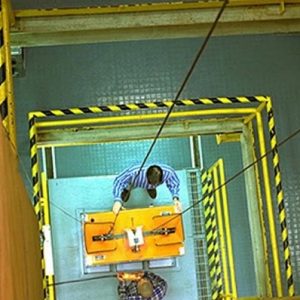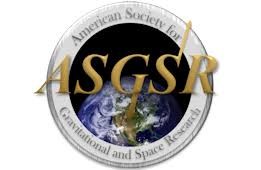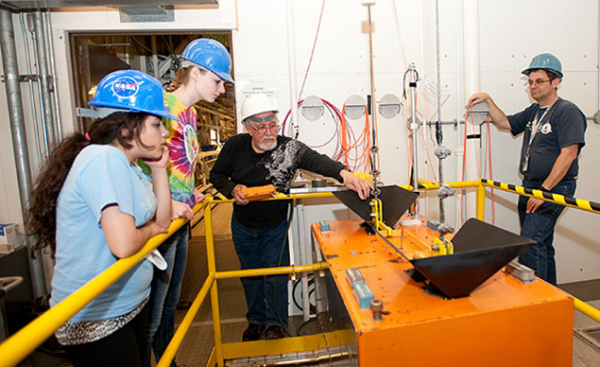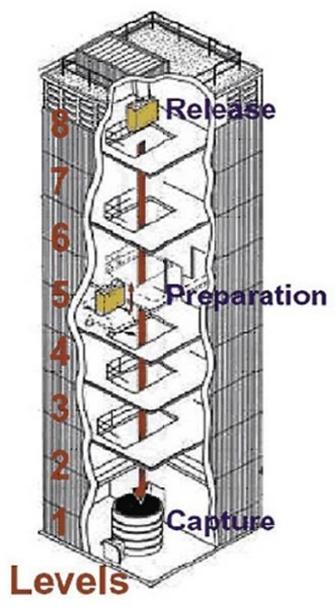2024 Drop Tower Challenge
Expulsion: Microgravity Expulsion from Water
WHAT?
Teams of grade 8-12 students are challenged to design and build simple devices which will float in water in normal gravity and will be expelled as far as possible from the water because of wetting characteristics when they experience apparent weightlessness, i.e., microgravity, in NASA’s 2.2 Second Drop Tower (shown below). To be clear, the expulsion must result from the hydrophilic or hydrophobic (‘water loving’ or ‘water fearing’) surface(s) of the objects and not because of mechanical means, such as released ballast.

Teams are only responsible for their surfacing devices, where NASA will provide the rest of the experimental hardware. After developing their concept(s), the youth prepare their proposal, consisting of conceptual drawing(s) and a short entry form, which is e-mailed to Ed-DropTower@lists.nasa.gov.
If selected, the youth prepare their test objects per guidelines provided on the challenge website. The devices are then sent to NASA where they will fall 24 meters (79 feet). Video results are provided for student analysis and reporting.
Expulsion of a ping pong ball in a 2.1-second drop test at Oregon’s Portland State University.
WHO?
This design challenge is for students in grades 8-12 from U.S. schools, including the fifty states, District of Columbia, Puerto Rico, American Samoa, Guam, the Northern Mariana Islands, the U.S. Virgin Islands, and all DODEA schools (which are for children of U.S. military personnel). Except for the DODEA schools, this challenge is not open to participants outside of the United States regardless of citizenship.
Teams will be favored over individuals in selection. Youth are expected to do most of the work, but may get help from adults, for example in building their test objects. Furthermore:
- Teams may be of any size, but a maximum of four students per team will be invited to the 2024 ASGSR meeting; see the next section.
- Each student may belong to no more than one team.
- Each team may submit no more than one proposal.
- An organization (e.g., school, science center, 4H club, Scout troop) may have many teams, but it may submit no more than two proposals to NASA. It is envisioned that no more than one proposal will be selected per organization.
SELECTION?
 NASA anticipates selecting up to 30 teams to build objects to be tested at the Glenn Research Center in Cleveland, Ohio. After evaluation of the experimental results and teams’ reports, a small number of top-performing teams will be invited to present their results in a student poster session at the 2024 meeting of the American Society for Gravitational and Space Research (ASGSR).
NASA anticipates selecting up to 30 teams to build objects to be tested at the Glenn Research Center in Cleveland, Ohio. After evaluation of the experimental results and teams’ reports, a small number of top-performing teams will be invited to present their results in a student poster session at the 2024 meeting of the American Society for Gravitational and Space Research (ASGSR).
WHERE?
Participation is remote, where participants do not travel to NASA for the testing. An exception is for those teams invited to present their results at the 2024 ASGSR meeting, but the location will not be announced until Nov. 2023.
COST?

There is no cost to participate in the challenge other than for (1) the preparation of the test objects, (2) the shipment of the test objects to NASA, and (3) travel costs for those invited to present their results at the ASGSR meeting. Regarding the latter, the ASGSR has normally provided travel support of $500 each for invited non-local students who present their results at the conference.
WHEN?
| 2023 Nov. 1 | deadline for proposal | |
| Early December | NASA announces teams selected for testing | |
| 2024 Jan.-February | preparation of test objects | |
| Feb. 15 | deadline for arrival of test objects at NASA | |
| Feb.-March | testing in NASA’s 2.2 Second Drop Tower | |
| April | analysis and report writing | |
| May 1 | deadline for written report | |
| Mid-May | NASA announces teams selected for ASGSR participation | |
| Fall 2024 | annual ASGSR meeting (probably in early November) | |
WHY?
 Participation in a nation-wide NASA design challenge could be good to include in college applications. And it is likely that your team will be selected for testing. Thus far, nearly 100% of the proposing teams have been selected for participation in this series of problem-based drop tower challenges.
Participation in a nation-wide NASA design challenge could be good to include in college applications. And it is likely that your team will be selected for testing. Thus far, nearly 100% of the proposing teams have been selected for participation in this series of problem-based drop tower challenges.
HINTS
- Design and build multiple test objects so that you can compare their results in your report and poster too if invited to present at the ASGSR meeting.
- Conduct your own microgravity trials. For inspiration, check out the Fire in Free Fall video by Dianna Cowern. The challenge staff can provide additional guidance.
DOWNLOADS
QUESTIONS?
Check the guide if available or email the challenge staff at Ed-DropTower@lists.nasa.gov.
